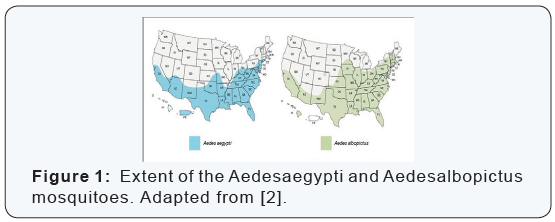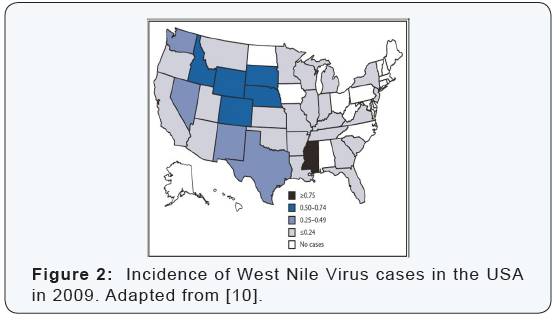Dengue Fever, West Nile and Zika Viruses spread by Mosquitoes and Nutritional Method to Possibly Stop Dengue from being Fatal
Kaufui V Wong*
Department of Mechanical and Aerospace Engineering, University of Miami, USA
Submission: September 28, 2016; Published: November 02, 2016
*Corresponding author: Kaufui V Wong, Department of Mechanical and Aerospace Engineering, University of Miami, USA
How to cite this article: Kaufui V Wong. Dengue Fever, West Nile and Zika Viruses spread by Mosquitoes and Nutritional Method to Possibly Stop 002 Dengue from being Fatal. Nutri Food Sci Int J. 2016; 1(3): 555565. DOI: 10.19080/NFSIJ.2016.01.555565
Abstract
It is common knowledge that the Aedes mosquitoes are the major vectors for the Dengue Fever (DF) virus and the Zika virus and the Culex mosquitoes are the major vectors for West Nile Virus (WNV). The Culex mosquito is a common mosquito in the United States of America (USA), as it is elsewhere in the world. The Zika virus is carried by the Aedes mosquitoes and possibly by the Culex mosquitoes. In this work, it is reasoned that all the mosquitoes mentioned could be capable of being vectors of these major viral diseases of concern. It is also known that the infected female Aedes mosquito can give rise to baby mosquitoes infected with the DF virus. Because of their similarity inlife-cycles, it is quite possible that the Culex, Aedes, and Anopheles mosquitoes can all spread DF, Zika and WNV. Thus, it is likely that DF, Zika and WNV can be spread to all 50 states of the USA. The spraying of insecticides over the rice fields of California may be unnecessary. Fishes which eat mosquito larvae should be preferred instead as a mitigation agent against the mosquitoes. Abstinence from meat could be considered a possible method to prevent DF from progressing to Dengue Hemorrhagic Fever (DHF).
Keywords:Fever; Vector; Aedes; Culex; Anopheles
Background and Literature Survey
It is established via laboratory as well as environmental studies, that the Aedes mosquitoes are the major vectors for the Dengue Fever (DF) virus and the Zika virus [1-3]; Additionally, it has been reported that theCulex mosquitoes can also carry the Zika virus [6, 7]. Work needs to be done to establish this later as a scientific fact.
When it comes to these disease viruses, it would seem that all the mosquitoes could be capable of being vectors. In comparison, the malaria protozoa seem to be carried by the Anophelesmosquito only.
When it comes to these disease viruses, it would seem that all the mosquitoes could be capable of being vectors. In comparison, the malaria protozoa seem to be carried by the Anophelesmosquito only. This could be due to the fact the malaria protozoa needs the human body to be part of its life-cycle. It is apparent that there is no need for this part to be present for a virus. It has been shown that the infected female Aedes mosquito can give rise to baby mosquitoes infected with the DF virus [8,9]. There is no necessity for baby mosquitoes to bite infected human beings to get infected with the DF virus. It is a strong suspicion of the author that it is the same for Zika and WNV. In other words, there is transovariol spreading of these disease viruses. Owing to their similarity of birthing – eggs, which grow into larvae in water, and then mature through the pupal stage into adult mosquitoes, it is the perspective of the author that the Culex, Aedes, and Anopheles mosquitoes could all spread DF, Zika and WNV. The biting of humans by the female mosquitoes is common to all of them. Thus, it is conceivable that DF, Zika and WNV could spread to all 50 states of the United States, from Florida to Alaska.
Zika, Dengue Fever and the Aedes Mosquito.

From Figure 1, it is clear that only nine of the 49 states shown are free of the Aedesaegypti and Aedesalbopictus mosquitoes. None of the east coast states are free of the Aedes mosquito, even Maine.
West Nile Virus and the Culex Mosquito

From Figure 2 [10], it can be seen that the Culex mosquito is in most of the states shown in the USA. Comparing Figure 1 and Figure 2, it can be seen that only North Dakota and Alaska seem to be free from the three viral diseases under discussion. At first glance, it might then follow that these two states may also be free from all three kinds of mosquitoes (proven disease vectors) being discussed in the current work. However, the state of Alaska Epidemiology Bulletin [11] publishes the following concern: “Many species of mosquitoes are known to carry and transmit WNV, some of which are endemic or have been found in Alaska (e.g. Aedescanadiensis, A. vexans, Culexpipiens, and C. restuans).” It is a perspective of the current work that the Aedescanadiensis and Aedesvexans in Alaska could potentially carry DF and the Zika virus. Furthermore, the various species of birds that carry the WNV can migrate to Alaska, a likelihood heightened by climate change. Crows and ravens were mentioned in [12]. These sentinel bird species for WNV are very common, which adds to the fuel for concern
In [13], it was stated clearly with respect to the breeding season and the disease-carrying season of mosquitoes in Alaska, namely that it is less than a month in the Arctic, about 4 months in the sub-Arctic and more than 5 months in temperate Alaska. A period of 2 months or more is commonly accepted as being enough time for mosquitoes to be a problem. Hence, the foregoing discussion leads to the deduction that Alaska could see cases of WNV in the future. In [14], it is stated that there are 36 mosquito species found in North Dakota; of these, 12 species are carriers of WNV. The paramount mosquito disease vector in North Dakota is the Culextarsalis. One good action in North Dakota that could be followed in other states (or other parts of the world) is that it has mosquito traps in all 53 counties [14]. The traps are serviced weekly and the samples sent to the state lab where their numbers are calculated. It is possible that these vigilant actions by the state agency has enabled North Dakota to declare ‘no cases’ in 2009 [14]. However, it was reported in [15], that between June 1 and September 9, 2016, there were 50 human cases of WNV in North Dakota, and 537 in the USA. That Hawaii did not have the WNV in 2009 is overshadowed by the number of cases of DF and Zika (in 2016) in that state. So it would seem that to date, Alaska is the only state without the WNV
Discussion and Conclusion
Some history of the spread of the viral diseases under discussion is given in [16]. Since the WNV was discovered in NYC in 1999, the number of WNV cases in California has been growing. As a mitigation action, the rice fields near Sacramento, CA, has been sprayed to kill the mosquitoes in these wet areas. It is noted that this environmentally unfriendly method may not be necessary. Fishes have been used to feed on mosquito larvae for generations in the paddy fields of China, Japan, Southeast Asia and South Asia. This strategy of using biological feeders of mosquito larvae as a defense should be encouraged in the USA. In addition, the use of mosquito traps as done in North Dakota may be replicated worldwide as a mosquito control action that could be helpful. With regards the minimal symptoms of many DF cases amongst its victims, and that there are no drugs to cure the disease if and when it progresses to Dengue Hemorrhagic Fever (DHF), clues have been extracted by this researcher from information gleaned from published literature and his own experiences
From the author’s paper [9], “a possible hypothesis is that the population with a vegetarian diet is less susceptible to the disease than a population that is not vegetarian. This hypothesis rests on the possible hypothesis that the dengue virus thrives less in the vegetarian’s blood. The published statements about the disease and nutrition [17] are undeniably very preliminary and it is still too early to make deductions.” In [18], Dr. Yen is described as informing that “the blood samples of vegetarians were too weak to sustain the dengue virus.” In addition, a family member passed away from DHF in Malaysia in 2015, even though he was very-well off and overweight and a nonvegetarian. This experience confirmed the hypothesis that the dengue virus probably thrives a lot in an omnivore’s blood, and hence more likely to progress from DF to DHF. It is a suggestion by the current work that abstinence from meat and possibly even fasting would be an easy, yet possibly effective method to decrease the progression of DF to DHF.
Through a logical and systematic review of the evidences, the main conclusion of this article has been deduced. The three major viral diseases spread by mosquitoes; Dengue Fever, Zika and West Nile Virus are capable of being spread throughout the USA, from Florida to Alaska. With a similar argument, these same modern scourges can spread from the tropics to the colder areas throughout the world. It is unlikely that humans can get rid of all mosquitoes completely. Likewise, it is unlikely to stop the spread of these diseases completely anytime soon.
The immediate strategy is to reduce the increase in yearly numbers that fall victim to the diseases. It has been shown that the best way to combat mosquitoes is to control them at the larval stages. More research work could be done to find the WNV in Aedes and Anopheles mosquitoes, and the Zika virus in Culex and Anopheles mosquitoes, as well as the DF virus in Culex and Anopheles mosquitoes. It is neither a scientifically proven fact nor a popularly accepted belief that all the three genera of mosquitoes can spread the three viral diseases discussed to most corners of the world where people live. Results would influence the strategy and planning of the World Health Organization (WHO) with regards these diseases, which have been increasing worldwide in this postmodern times. The premise that all three viral diseases are existential threats in most parts of the world should be investigated.
Acknowledgment
This work is dedicated to all the victims of mosquito-borne diseases worldwide, especially to those who have passed away.
References
- https://en.wikipedia.org/wiki/Aedes
- http://www.cdc.gov/dengue/epidemiology/
- https://www.cdc.gov/zika/
- https://en.wikipedia.org/wiki/Culex
- https://extension.entm.purdue.edu/publichealth/insects/mosquito. html
- http://www.ndtv.com/health
- http://edition.cnn.com/2016/07/22/health/zika-culex-mosquitobrazil/
- World Health Organization (2009) Dengue: guidelines for diagnosis, treatment, prevention and control. WHO, Geneva, Switzerland, p. 3–12.
- Wong KV (2015) Dengue Fever Rising. J of Disease and Global Health 4(2): 52-57.
- Centers of Disease Control (2010) West Nile Distribution in the United States, 2009. CDC 59(25): 769-772.
- Middaugh J (2002) The Threat of West Nile Virus in Alaska. State of Alaska Epidemiology Bulletin, Alaska.
- https://seagrant.uaf.edu/news/04ASJ/09.03.04west-nile.html
- Frohne W (1954) Mosquito distribution in Alaska with especial reference to a new type of life cycle. Mosquito News 14(1): 10-13.
- http://www.ndhealth.gov/WNV/Mosquito/Default.html
- http://www.ndhealth.gov/WNV/Data/State.aspx
- Fauci AS, Morens DM (2016) Zika virus in the Americas--yet another arbovirus threat. N Engl J Med 374(7): 601-604.
- Kyle JL, Harris E (2008) Global spread and persistence of dengue. Annu Rev Microbiol 62: 71-92.
- http://www.cbsnews.com/news/vietnam-releases-mosquito-withbacteria- that-blocks-dengue-fever/







